Health IT Policy: Federal Government Initiatives, Challenges and Goals
VerifiedAdded on 2023/05/30
|7
|1639
|476
Report
AI Summary
This report analyzes the future of Health IT policy, focusing on the Federal Health IT Strategic Plan 2015-2020. It examines how federal initiatives and regulations have accelerated Health IT adoption, highlighting the use of Electronic Health Records (EHRs) and secure health information exchange. The report identifies key challenges facing the healthcare industry and policymakers, including rising costs, workforce shortages, and coordination issues. Furthermore, it explores potential goals for future strategic plans, such as cost-cutting measures, workforce expansion, and policy implementation improvements. The analysis includes an overview of the initiatives by the Office of the National Coordinator for Health Information Technology (ONC), the impact of the Health Information Technology for Economic and Clinical Health (HITECH) Act, and the strategies and accomplishments of the government in the adoption of Health IT. The report concludes by emphasizing the importance of collaborative efforts to improve healthcare IT and policy implementation.
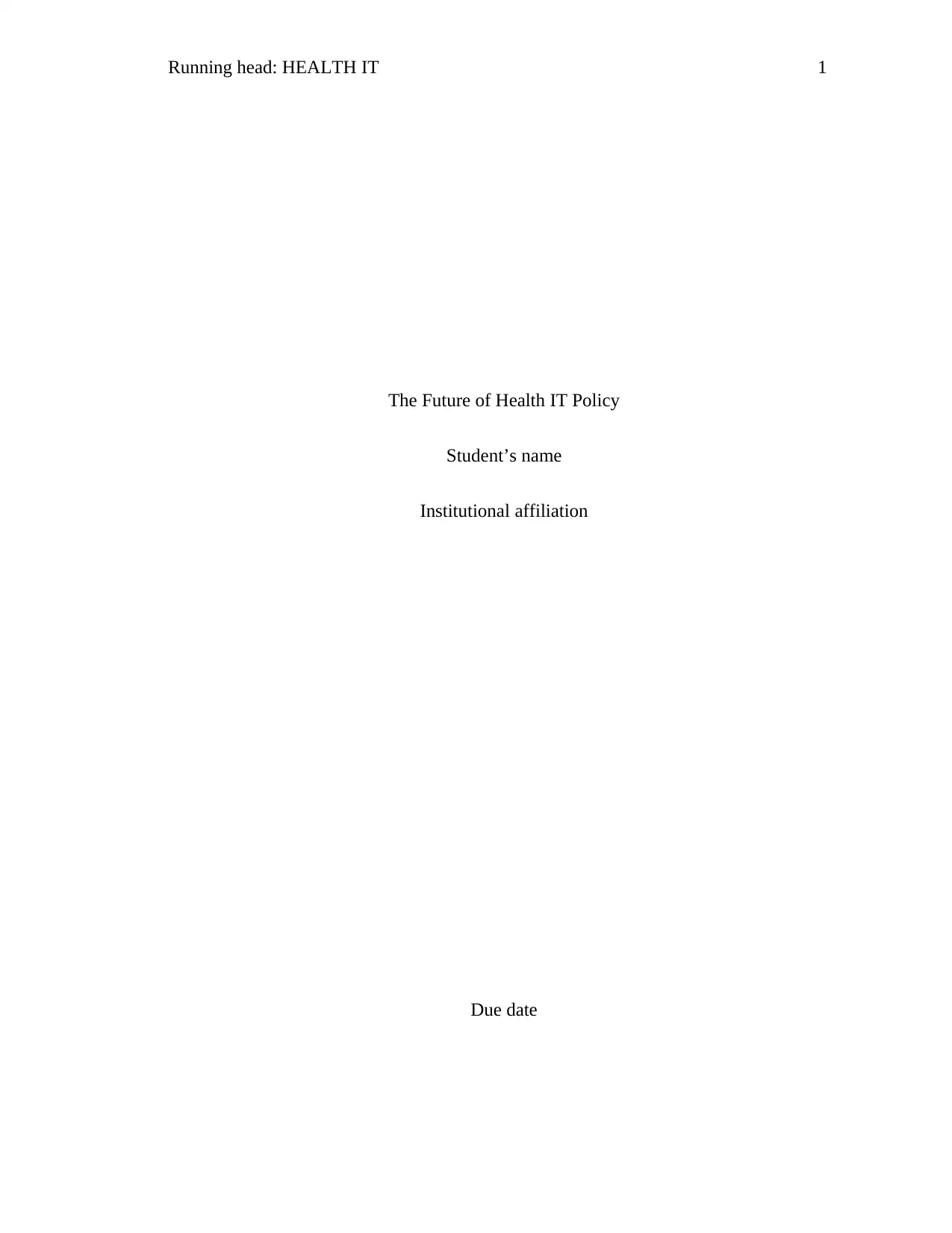
Running head: HEALTH IT 1
The Future of Health IT Policy
Student’s name
Institutional affiliation
Due date
The Future of Health IT Policy
Student’s name
Institutional affiliation
Due date
Paraphrase This Document
Need a fresh take? Get an instant paraphrase of this document with our AI Paraphraser
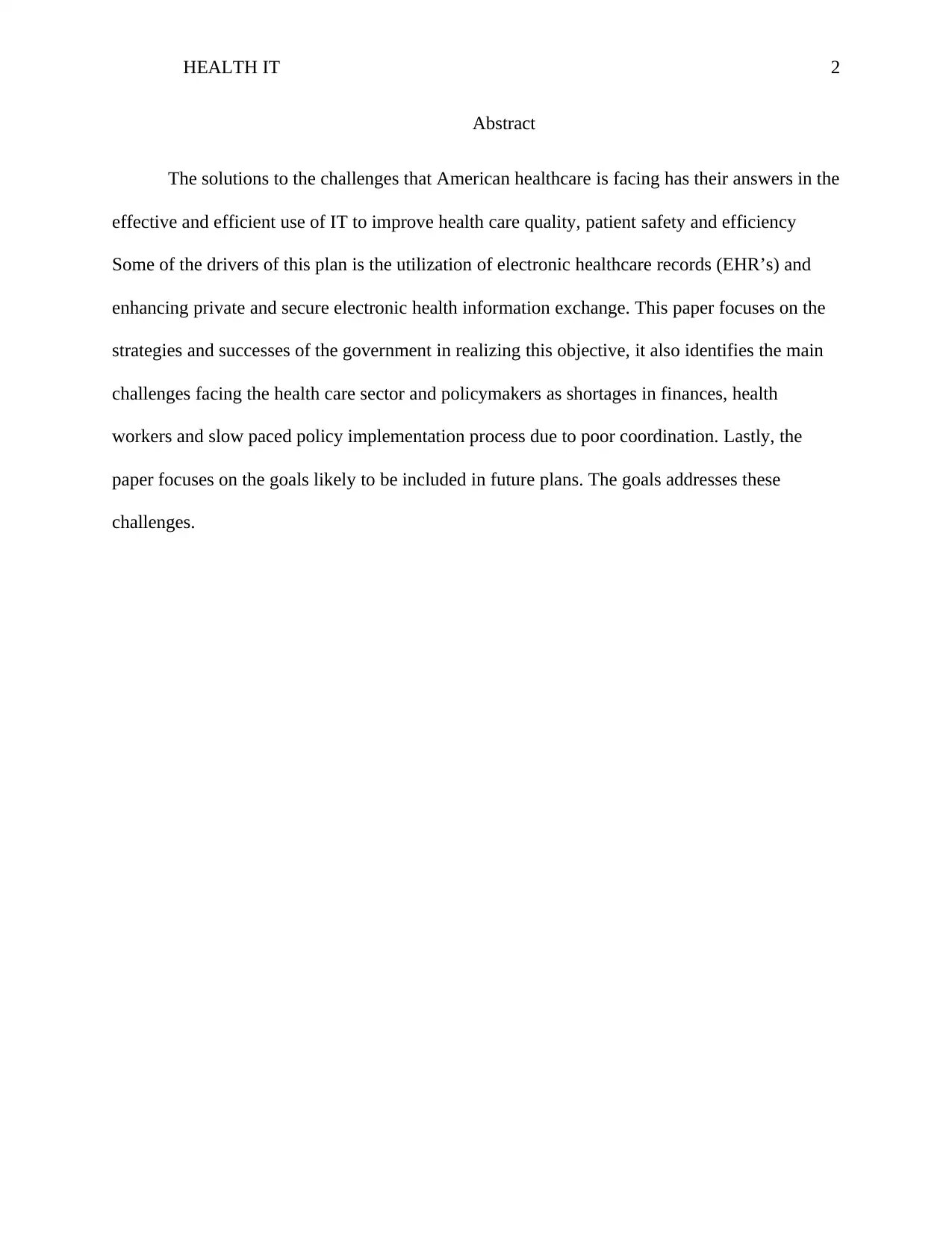
HEALTH IT 2
Abstract
The solutions to the challenges that American healthcare is facing has their answers in the
effective and efficient use of IT to improve health care quality, patient safety and efficiency
Some of the drivers of this plan is the utilization of electronic healthcare records (EHR’s) and
enhancing private and secure electronic health information exchange. This paper focuses on the
strategies and successes of the government in realizing this objective, it also identifies the main
challenges facing the health care sector and policymakers as shortages in finances, health
workers and slow paced policy implementation process due to poor coordination. Lastly, the
paper focuses on the goals likely to be included in future plans. The goals addresses these
challenges.
Abstract
The solutions to the challenges that American healthcare is facing has their answers in the
effective and efficient use of IT to improve health care quality, patient safety and efficiency
Some of the drivers of this plan is the utilization of electronic healthcare records (EHR’s) and
enhancing private and secure electronic health information exchange. This paper focuses on the
strategies and successes of the government in realizing this objective, it also identifies the main
challenges facing the health care sector and policymakers as shortages in finances, health
workers and slow paced policy implementation process due to poor coordination. Lastly, the
paper focuses on the goals likely to be included in future plans. The goals addresses these
challenges.
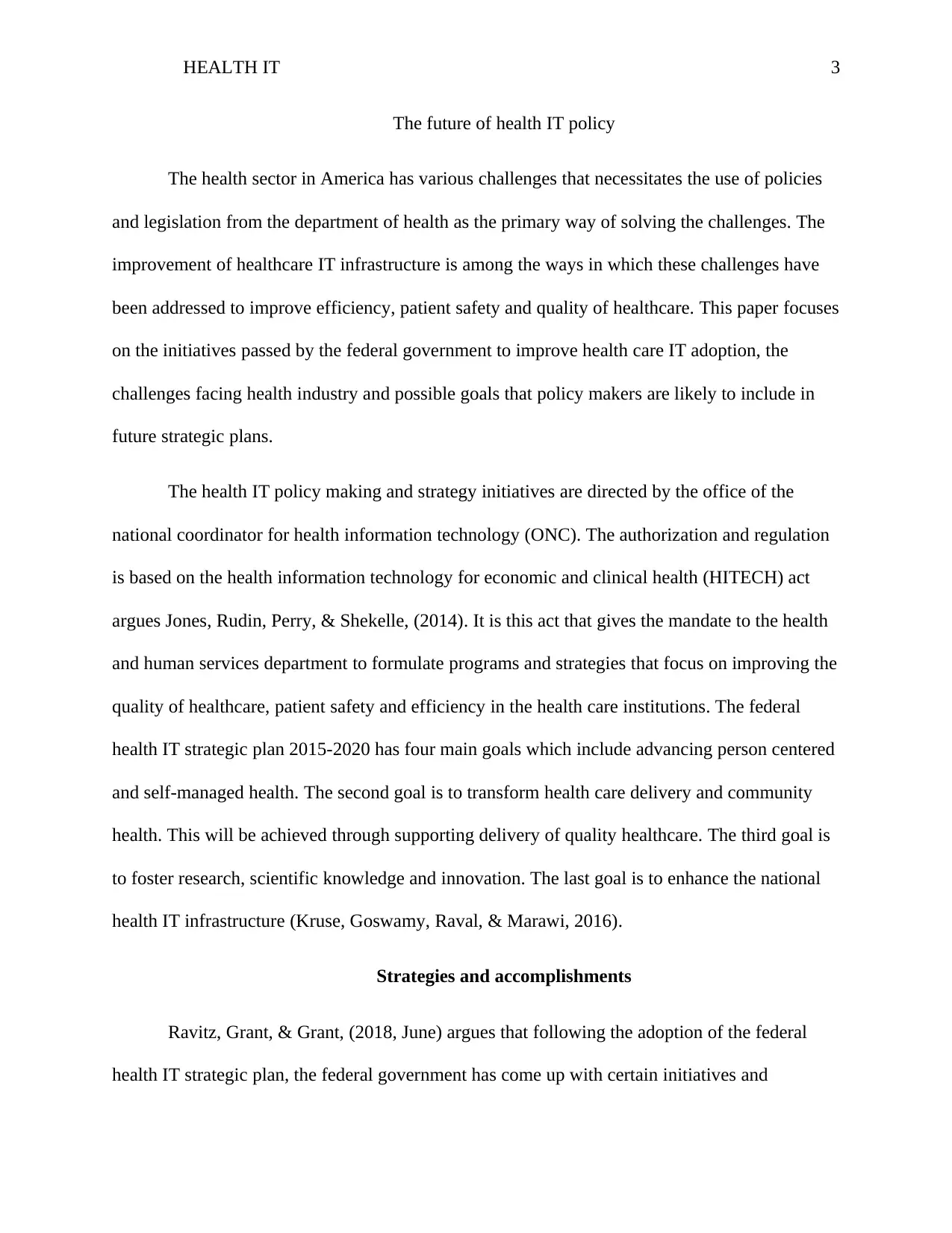
HEALTH IT 3
The future of health IT policy
The health sector in America has various challenges that necessitates the use of policies
and legislation from the department of health as the primary way of solving the challenges. The
improvement of healthcare IT infrastructure is among the ways in which these challenges have
been addressed to improve efficiency, patient safety and quality of healthcare. This paper focuses
on the initiatives passed by the federal government to improve health care IT adoption, the
challenges facing health industry and possible goals that policy makers are likely to include in
future strategic plans.
The health IT policy making and strategy initiatives are directed by the office of the
national coordinator for health information technology (ONC). The authorization and regulation
is based on the health information technology for economic and clinical health (HITECH) act
argues Jones, Rudin, Perry, & Shekelle, (2014). It is this act that gives the mandate to the health
and human services department to formulate programs and strategies that focus on improving the
quality of healthcare, patient safety and efficiency in the health care institutions. The federal
health IT strategic plan 2015-2020 has four main goals which include advancing person centered
and self-managed health. The second goal is to transform health care delivery and community
health. This will be achieved through supporting delivery of quality healthcare. The third goal is
to foster research, scientific knowledge and innovation. The last goal is to enhance the national
health IT infrastructure (Kruse, Goswamy, Raval, & Marawi, 2016).
Strategies and accomplishments
Ravitz, Grant, & Grant, (2018, June) argues that following the adoption of the federal
health IT strategic plan, the federal government has come up with certain initiatives and
The future of health IT policy
The health sector in America has various challenges that necessitates the use of policies
and legislation from the department of health as the primary way of solving the challenges. The
improvement of healthcare IT infrastructure is among the ways in which these challenges have
been addressed to improve efficiency, patient safety and quality of healthcare. This paper focuses
on the initiatives passed by the federal government to improve health care IT adoption, the
challenges facing health industry and possible goals that policy makers are likely to include in
future strategic plans.
The health IT policy making and strategy initiatives are directed by the office of the
national coordinator for health information technology (ONC). The authorization and regulation
is based on the health information technology for economic and clinical health (HITECH) act
argues Jones, Rudin, Perry, & Shekelle, (2014). It is this act that gives the mandate to the health
and human services department to formulate programs and strategies that focus on improving the
quality of healthcare, patient safety and efficiency in the health care institutions. The federal
health IT strategic plan 2015-2020 has four main goals which include advancing person centered
and self-managed health. The second goal is to transform health care delivery and community
health. This will be achieved through supporting delivery of quality healthcare. The third goal is
to foster research, scientific knowledge and innovation. The last goal is to enhance the national
health IT infrastructure (Kruse, Goswamy, Raval, & Marawi, 2016).
Strategies and accomplishments
Ravitz, Grant, & Grant, (2018, June) argues that following the adoption of the federal
health IT strategic plan, the federal government has come up with certain initiatives and
⊘ This is a preview!⊘
Do you want full access?
Subscribe today to unlock all pages.

Trusted by 1+ million students worldwide
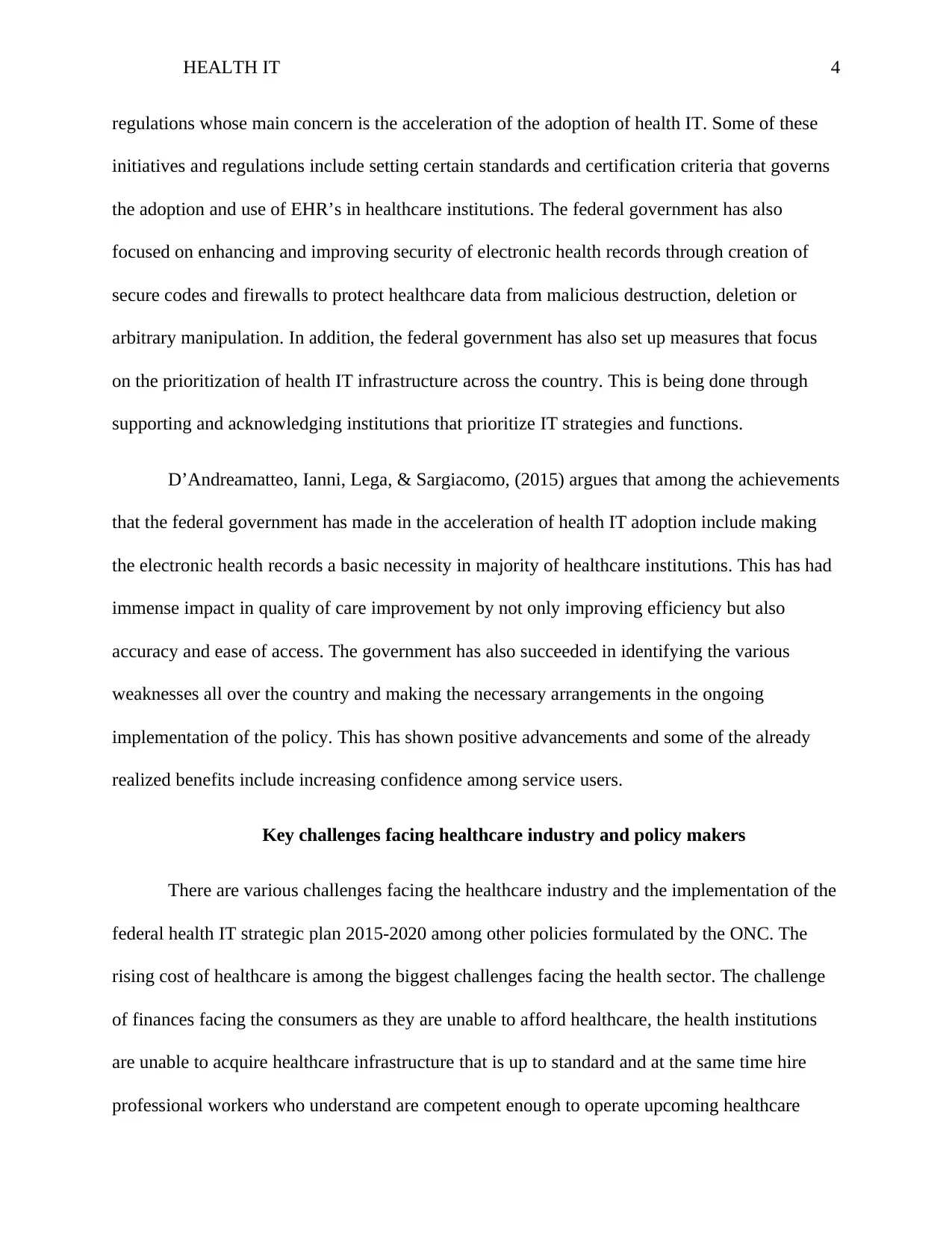
HEALTH IT 4
regulations whose main concern is the acceleration of the adoption of health IT. Some of these
initiatives and regulations include setting certain standards and certification criteria that governs
the adoption and use of EHR’s in healthcare institutions. The federal government has also
focused on enhancing and improving security of electronic health records through creation of
secure codes and firewalls to protect healthcare data from malicious destruction, deletion or
arbitrary manipulation. In addition, the federal government has also set up measures that focus
on the prioritization of health IT infrastructure across the country. This is being done through
supporting and acknowledging institutions that prioritize IT strategies and functions.
D’Andreamatteo, Ianni, Lega, & Sargiacomo, (2015) argues that among the achievements
that the federal government has made in the acceleration of health IT adoption include making
the electronic health records a basic necessity in majority of healthcare institutions. This has had
immense impact in quality of care improvement by not only improving efficiency but also
accuracy and ease of access. The government has also succeeded in identifying the various
weaknesses all over the country and making the necessary arrangements in the ongoing
implementation of the policy. This has shown positive advancements and some of the already
realized benefits include increasing confidence among service users.
Key challenges facing healthcare industry and policy makers
There are various challenges facing the healthcare industry and the implementation of the
federal health IT strategic plan 2015-2020 among other policies formulated by the ONC. The
rising cost of healthcare is among the biggest challenges facing the health sector. The challenge
of finances facing the consumers as they are unable to afford healthcare, the health institutions
are unable to acquire healthcare infrastructure that is up to standard and at the same time hire
professional workers who understand are competent enough to operate upcoming healthcare
regulations whose main concern is the acceleration of the adoption of health IT. Some of these
initiatives and regulations include setting certain standards and certification criteria that governs
the adoption and use of EHR’s in healthcare institutions. The federal government has also
focused on enhancing and improving security of electronic health records through creation of
secure codes and firewalls to protect healthcare data from malicious destruction, deletion or
arbitrary manipulation. In addition, the federal government has also set up measures that focus
on the prioritization of health IT infrastructure across the country. This is being done through
supporting and acknowledging institutions that prioritize IT strategies and functions.
D’Andreamatteo, Ianni, Lega, & Sargiacomo, (2015) argues that among the achievements
that the federal government has made in the acceleration of health IT adoption include making
the electronic health records a basic necessity in majority of healthcare institutions. This has had
immense impact in quality of care improvement by not only improving efficiency but also
accuracy and ease of access. The government has also succeeded in identifying the various
weaknesses all over the country and making the necessary arrangements in the ongoing
implementation of the policy. This has shown positive advancements and some of the already
realized benefits include increasing confidence among service users.
Key challenges facing healthcare industry and policy makers
There are various challenges facing the healthcare industry and the implementation of the
federal health IT strategic plan 2015-2020 among other policies formulated by the ONC. The
rising cost of healthcare is among the biggest challenges facing the health sector. The challenge
of finances facing the consumers as they are unable to afford healthcare, the health institutions
are unable to acquire healthcare infrastructure that is up to standard and at the same time hire
professional workers who understand are competent enough to operate upcoming healthcare
Paraphrase This Document
Need a fresh take? Get an instant paraphrase of this document with our AI Paraphraser
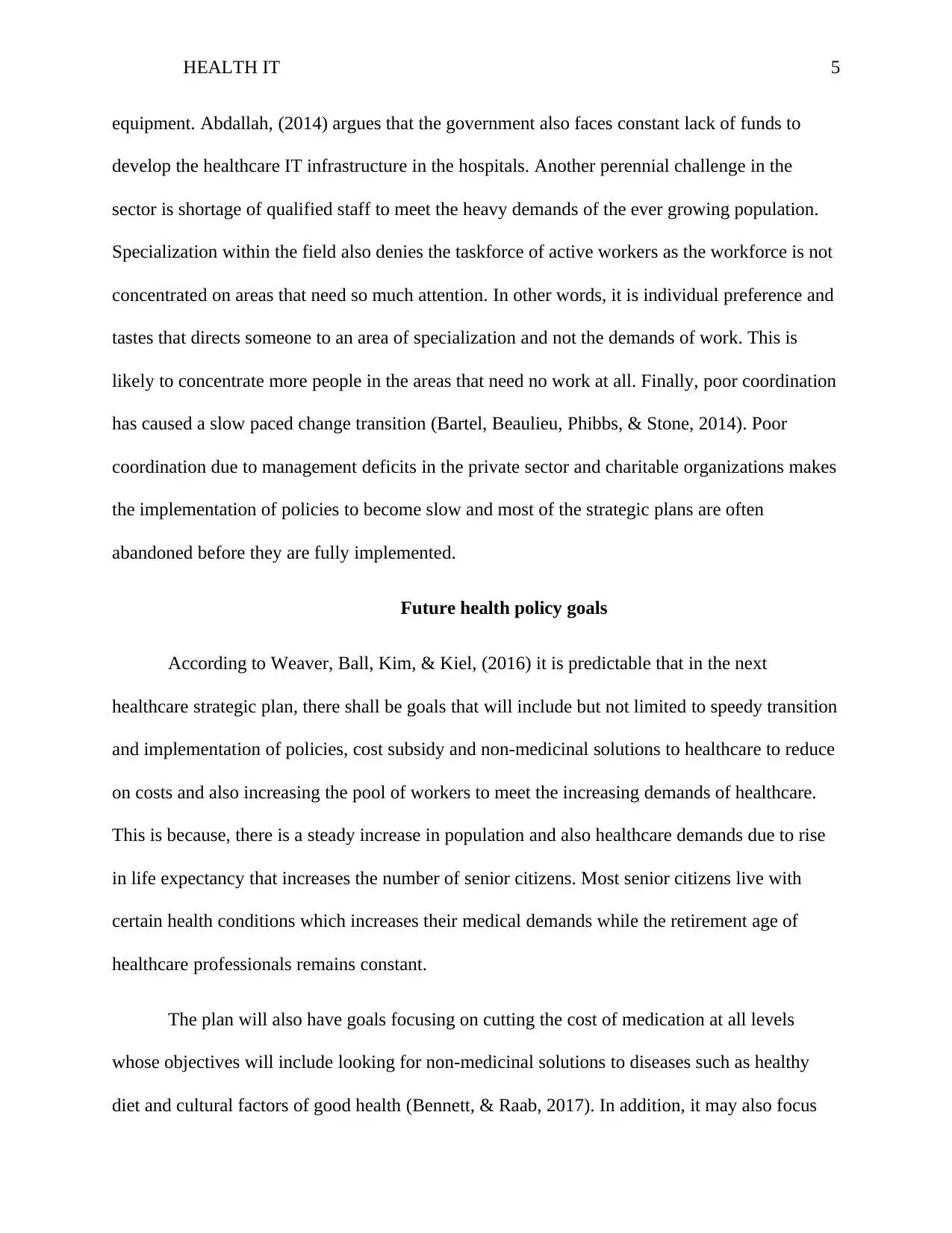
HEALTH IT 5
equipment. Abdallah, (2014) argues that the government also faces constant lack of funds to
develop the healthcare IT infrastructure in the hospitals. Another perennial challenge in the
sector is shortage of qualified staff to meet the heavy demands of the ever growing population.
Specialization within the field also denies the taskforce of active workers as the workforce is not
concentrated on areas that need so much attention. In other words, it is individual preference and
tastes that directs someone to an area of specialization and not the demands of work. This is
likely to concentrate more people in the areas that need no work at all. Finally, poor coordination
has caused a slow paced change transition (Bartel, Beaulieu, Phibbs, & Stone, 2014). Poor
coordination due to management deficits in the private sector and charitable organizations makes
the implementation of policies to become slow and most of the strategic plans are often
abandoned before they are fully implemented.
Future health policy goals
According to Weaver, Ball, Kim, & Kiel, (2016) it is predictable that in the next
healthcare strategic plan, there shall be goals that will include but not limited to speedy transition
and implementation of policies, cost subsidy and non-medicinal solutions to healthcare to reduce
on costs and also increasing the pool of workers to meet the increasing demands of healthcare.
This is because, there is a steady increase in population and also healthcare demands due to rise
in life expectancy that increases the number of senior citizens. Most senior citizens live with
certain health conditions which increases their medical demands while the retirement age of
healthcare professionals remains constant.
The plan will also have goals focusing on cutting the cost of medication at all levels
whose objectives will include looking for non-medicinal solutions to diseases such as healthy
diet and cultural factors of good health (Bennett, & Raab, 2017). In addition, it may also focus
equipment. Abdallah, (2014) argues that the government also faces constant lack of funds to
develop the healthcare IT infrastructure in the hospitals. Another perennial challenge in the
sector is shortage of qualified staff to meet the heavy demands of the ever growing population.
Specialization within the field also denies the taskforce of active workers as the workforce is not
concentrated on areas that need so much attention. In other words, it is individual preference and
tastes that directs someone to an area of specialization and not the demands of work. This is
likely to concentrate more people in the areas that need no work at all. Finally, poor coordination
has caused a slow paced change transition (Bartel, Beaulieu, Phibbs, & Stone, 2014). Poor
coordination due to management deficits in the private sector and charitable organizations makes
the implementation of policies to become slow and most of the strategic plans are often
abandoned before they are fully implemented.
Future health policy goals
According to Weaver, Ball, Kim, & Kiel, (2016) it is predictable that in the next
healthcare strategic plan, there shall be goals that will include but not limited to speedy transition
and implementation of policies, cost subsidy and non-medicinal solutions to healthcare to reduce
on costs and also increasing the pool of workers to meet the increasing demands of healthcare.
This is because, there is a steady increase in population and also healthcare demands due to rise
in life expectancy that increases the number of senior citizens. Most senior citizens live with
certain health conditions which increases their medical demands while the retirement age of
healthcare professionals remains constant.
The plan will also have goals focusing on cutting the cost of medication at all levels
whose objectives will include looking for non-medicinal solutions to diseases such as healthy
diet and cultural factors of good health (Bennett, & Raab, 2017). In addition, it may also focus
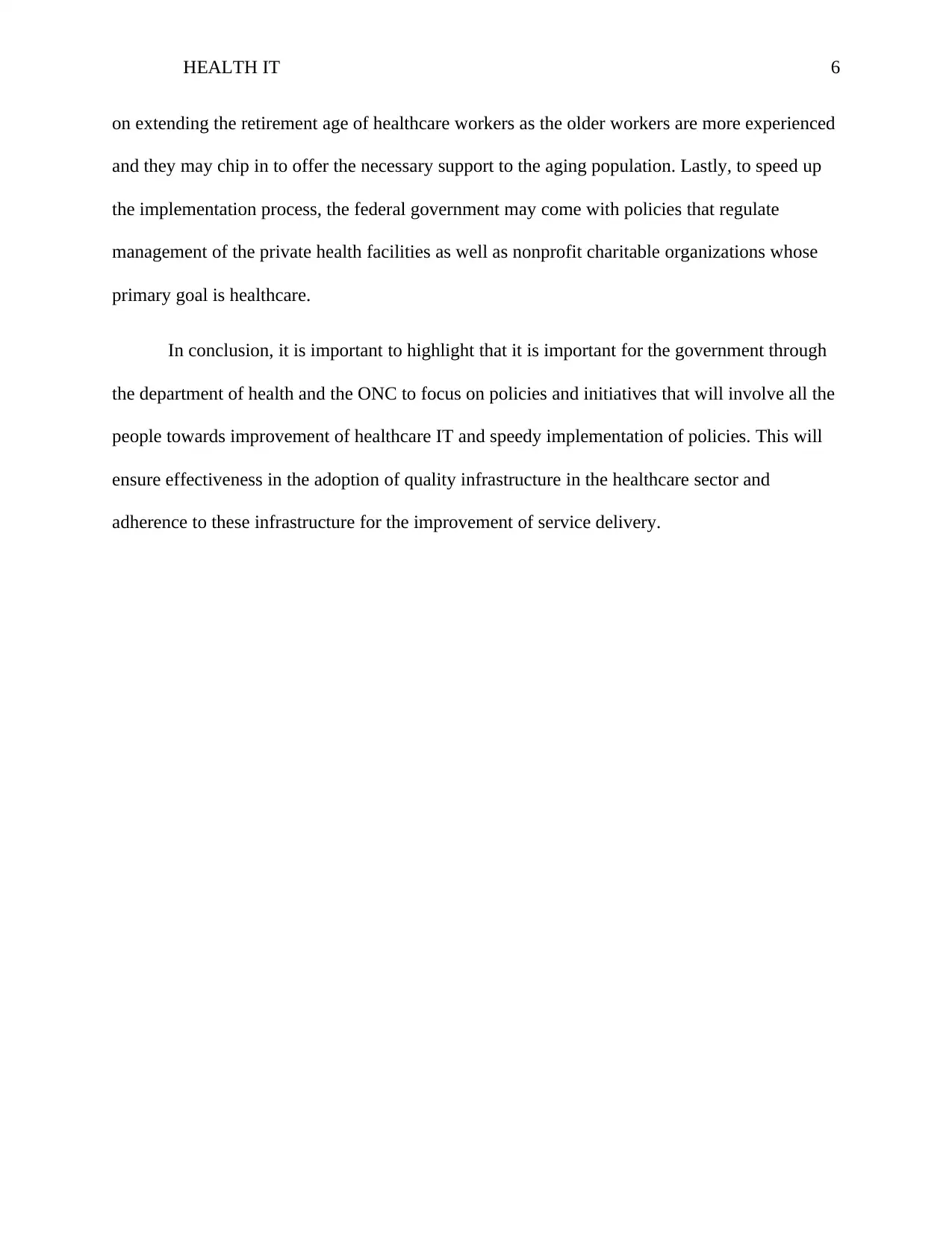
HEALTH IT 6
on extending the retirement age of healthcare workers as the older workers are more experienced
and they may chip in to offer the necessary support to the aging population. Lastly, to speed up
the implementation process, the federal government may come with policies that regulate
management of the private health facilities as well as nonprofit charitable organizations whose
primary goal is healthcare.
In conclusion, it is important to highlight that it is important for the government through
the department of health and the ONC to focus on policies and initiatives that will involve all the
people towards improvement of healthcare IT and speedy implementation of policies. This will
ensure effectiveness in the adoption of quality infrastructure in the healthcare sector and
adherence to these infrastructure for the improvement of service delivery.
on extending the retirement age of healthcare workers as the older workers are more experienced
and they may chip in to offer the necessary support to the aging population. Lastly, to speed up
the implementation process, the federal government may come with policies that regulate
management of the private health facilities as well as nonprofit charitable organizations whose
primary goal is healthcare.
In conclusion, it is important to highlight that it is important for the government through
the department of health and the ONC to focus on policies and initiatives that will involve all the
people towards improvement of healthcare IT and speedy implementation of policies. This will
ensure effectiveness in the adoption of quality infrastructure in the healthcare sector and
adherence to these infrastructure for the improvement of service delivery.
⊘ This is a preview!⊘
Do you want full access?
Subscribe today to unlock all pages.

Trusted by 1+ million students worldwide
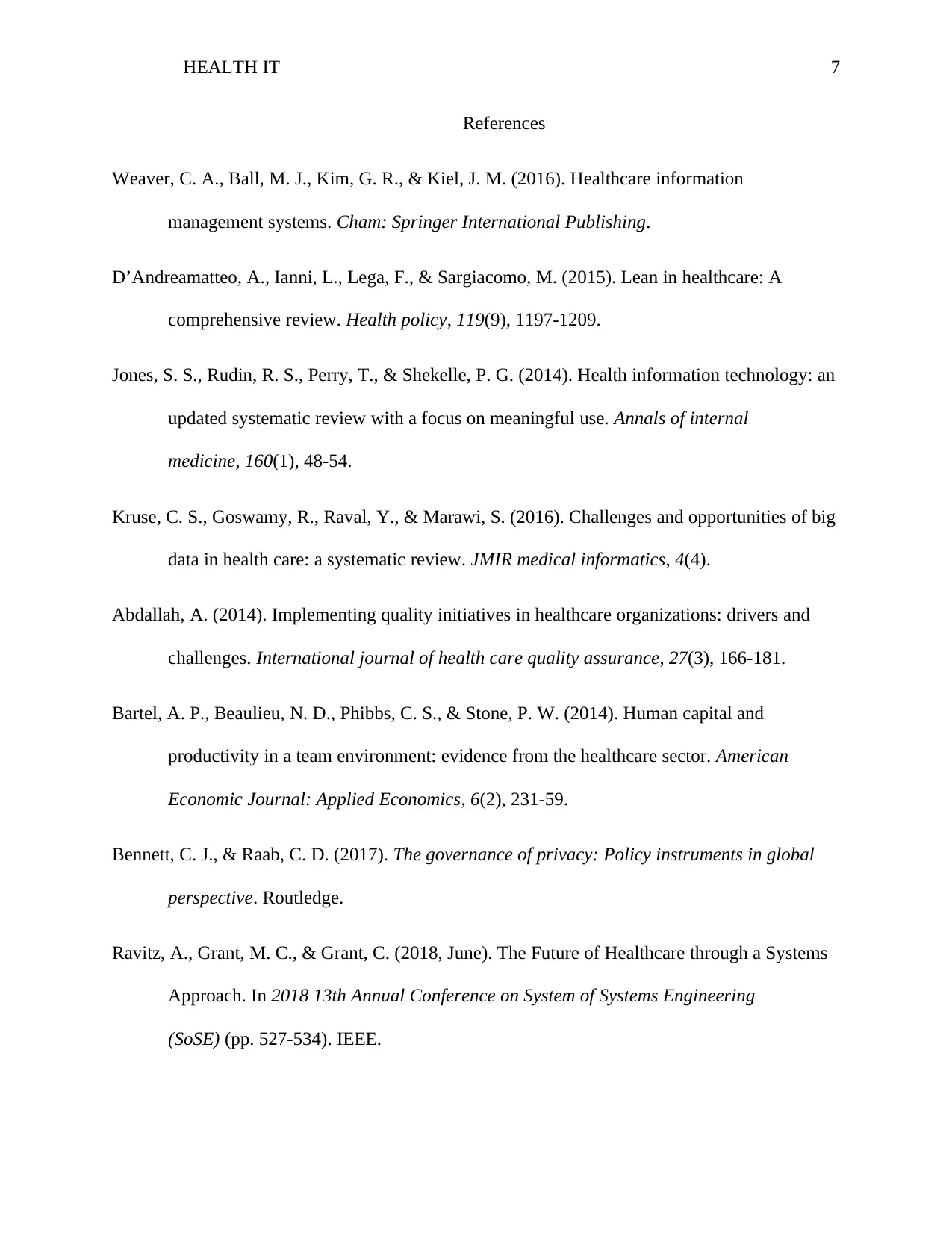
HEALTH IT 7
References
Weaver, C. A., Ball, M. J., Kim, G. R., & Kiel, J. M. (2016). Healthcare information
management systems. Cham: Springer International Publishing.
D’Andreamatteo, A., Ianni, L., Lega, F., & Sargiacomo, M. (2015). Lean in healthcare: A
comprehensive review. Health policy, 119(9), 1197-1209.
Jones, S. S., Rudin, R. S., Perry, T., & Shekelle, P. G. (2014). Health information technology: an
updated systematic review with a focus on meaningful use. Annals of internal
medicine, 160(1), 48-54.
Kruse, C. S., Goswamy, R., Raval, Y., & Marawi, S. (2016). Challenges and opportunities of big
data in health care: a systematic review. JMIR medical informatics, 4(4).
Abdallah, A. (2014). Implementing quality initiatives in healthcare organizations: drivers and
challenges. International journal of health care quality assurance, 27(3), 166-181.
Bartel, A. P., Beaulieu, N. D., Phibbs, C. S., & Stone, P. W. (2014). Human capital and
productivity in a team environment: evidence from the healthcare sector. American
Economic Journal: Applied Economics, 6(2), 231-59.
Bennett, C. J., & Raab, C. D. (2017). The governance of privacy: Policy instruments in global
perspective. Routledge.
Ravitz, A., Grant, M. C., & Grant, C. (2018, June). The Future of Healthcare through a Systems
Approach. In 2018 13th Annual Conference on System of Systems Engineering
(SoSE) (pp. 527-534). IEEE.
References
Weaver, C. A., Ball, M. J., Kim, G. R., & Kiel, J. M. (2016). Healthcare information
management systems. Cham: Springer International Publishing.
D’Andreamatteo, A., Ianni, L., Lega, F., & Sargiacomo, M. (2015). Lean in healthcare: A
comprehensive review. Health policy, 119(9), 1197-1209.
Jones, S. S., Rudin, R. S., Perry, T., & Shekelle, P. G. (2014). Health information technology: an
updated systematic review with a focus on meaningful use. Annals of internal
medicine, 160(1), 48-54.
Kruse, C. S., Goswamy, R., Raval, Y., & Marawi, S. (2016). Challenges and opportunities of big
data in health care: a systematic review. JMIR medical informatics, 4(4).
Abdallah, A. (2014). Implementing quality initiatives in healthcare organizations: drivers and
challenges. International journal of health care quality assurance, 27(3), 166-181.
Bartel, A. P., Beaulieu, N. D., Phibbs, C. S., & Stone, P. W. (2014). Human capital and
productivity in a team environment: evidence from the healthcare sector. American
Economic Journal: Applied Economics, 6(2), 231-59.
Bennett, C. J., & Raab, C. D. (2017). The governance of privacy: Policy instruments in global
perspective. Routledge.
Ravitz, A., Grant, M. C., & Grant, C. (2018, June). The Future of Healthcare through a Systems
Approach. In 2018 13th Annual Conference on System of Systems Engineering
(SoSE) (pp. 527-534). IEEE.
1 out of 7
Related Documents
Your All-in-One AI-Powered Toolkit for Academic Success.
+13062052269
info@desklib.com
Available 24*7 on WhatsApp / Email
![[object Object]](/_next/static/media/star-bottom.7253800d.svg)
Unlock your academic potential
Copyright © 2020–2025 A2Z Services. All Rights Reserved. Developed and managed by ZUCOL.




